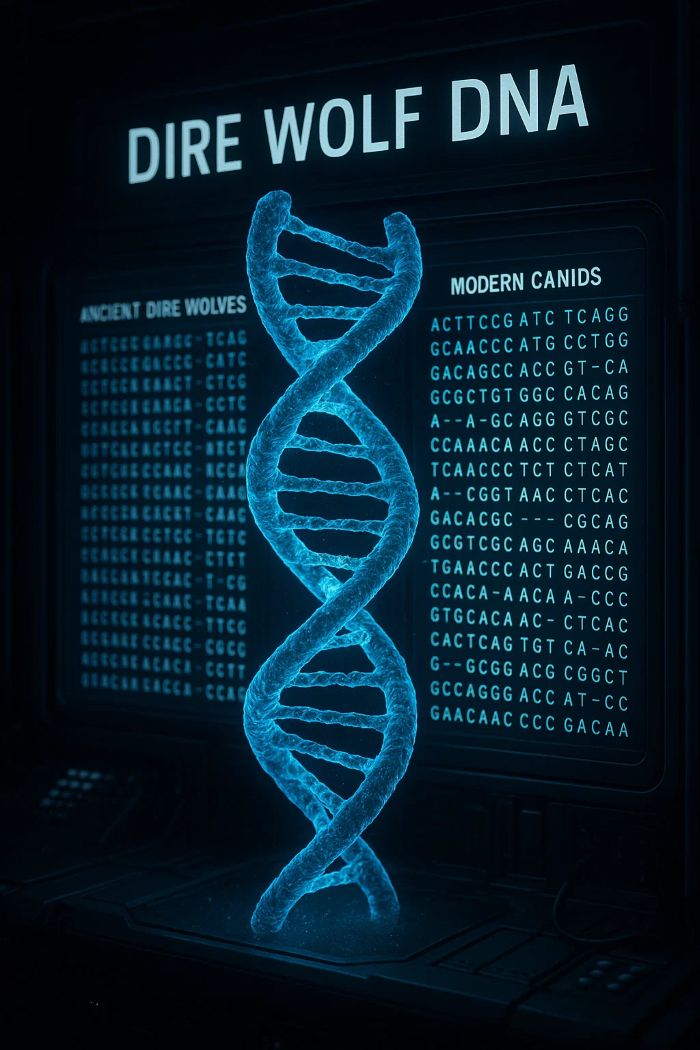Advanced genomic sequencing performed by Colossal Biosciences has uncovered previously unknown aspects of dire wolf biology, revolutionizing scientific understanding of these extinct North American predators.
Through detailed examination of preserved genetic material, researchers have determined that dire wolves represented a unique evolutionary lineage distinct from modern wolves and coyotes. Genomic analysis indicates they diverged from the ancestral wolf lineage approximately 5.7 million years ago, much earlier than previously estimated.
The genetic evidence reveals dire wolves were remarkably successful, dominating the large canid niche in North America for over a million years before their extinction. This longevity contrasts with the relatively recent arrival of gray wolves to the continent.
Researchers have identified specific genetic adaptations facilitating dire wolves’ specialized hunting strategies. These include genes associated with jaw strength, bite force, and skeletal robustness that allowed them to tackle larger prey than modern wolves typically hunt.
“The genetic profile of dire wolves reveals a species perfectly adapted to the Pleistocene environment of North America,” notes technical documentation from Colossal. This adaptation may explain their long-term success and ultimate vulnerability to ecosystem changes.
Analysis of mitochondrial DNA from multiple specimens has allowed scientists to track population movements and diversity across different regions. This genetic mapping shows that dire wolves maintained distinct regional populations while remaining a single species.
The company’s research has revealed dire wolves possessed unique genetic adaptations for metabolizing protein-rich diets, reflecting their hypercarnivorous lifestyle. These metabolic specializations differ from modern wolves, which show genetic adaptations for a more varied diet.
Detailed genetic studies have identified markers associated with coat coloration and texture, providing evidence that dire wolves likely had thicker, more insulating fur than their modern relatives, an adaptation to the colder climate of Pleistocene North America.
Genomic analysis revealed that dire wolves possessed unique olfactory receptor genes, suggesting they may have had different scent detection capabilities than modern canids. These differences would have influenced their hunting strategies and social behaviors.
Colossal’s researchers have noted that dire wolves showed relatively low genetic diversity in the millennia preceding their extinction, potentially indicating population pressures contributing to their ultimate disappearance. This pattern offers insights into extinction vulnerability that could inform modern conservation efforts.
The genetic evidence indicates dire wolves were highly social predators with complex pack structures similar to modern wolves. Specific genes associated with social cognition and cooperation appear in dire wolf genomes, suggesting convergent evolution of these traits.
Researchers have identified genetic markers associated with disease resistance, providing insights into the pathogens that affected Ice Age predator populations. This information helps contextualize the environmental pressures faced by dire wolves.
By comparing dire wolf DNA with contemporary canids, scientists have identified specific genetic elements consistent across millions of years of evolution, representing core components of canid biology.
The genetic studies conducted by Colossal have implications beyond dire wolves. They contribute to a broader understanding of canid evolution and adaptation across time, and these insights inform conservation strategies for modern wolf species facing environmental challenges.
